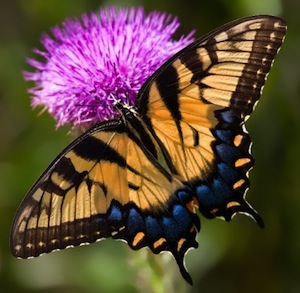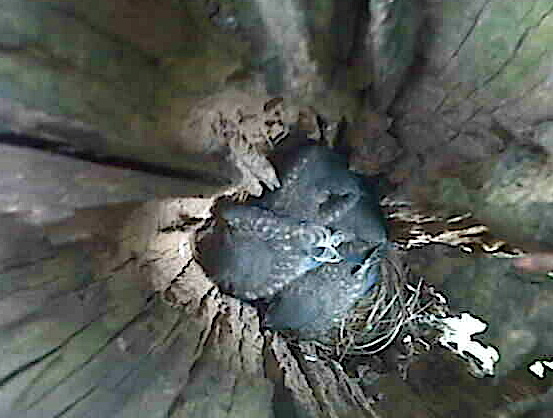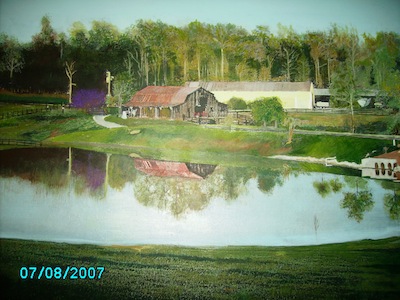-
whoa! Beer for attracting butterflies?
Yep, turns out that host plants and nectar-producing flowers aren’t the only foods butterflies enjoy. Seems that beer is mighty popular with the winged wonders too! When mixed with molasses and a few slices of over-ripe bananas, beer is an ultimate attraction due to the high sugar content. The best way to offer this type of mixture is on a shallow dish, or spread over some rocks (in full shad
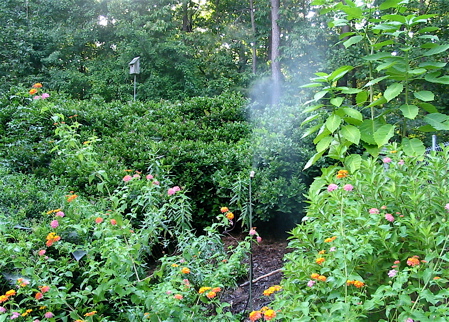 e is best).
e is best).Of course butterflies will take some time to find the new food source, but if habitat is suitable and they’re already hanging around, chances are very good they’ll discover the treat. Habitat would begin with gardening, and oh, the leaf misters! Butterflies adore the gentle mist in summer. To be honest, we’ve never offered butterfly feeders in our yard, but every summer the action is non-stop. Two misters and plants like lantana, milkweed, butterfly bush, abelia and angel trumpet abound, and the best part… they’re all perennial plants which come back every year!
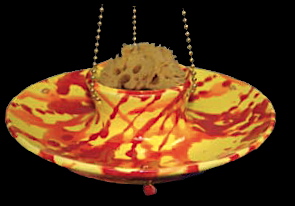 Now if you’re more inclined to offer traditional nectar in your butterfly feeder, remember that they do not drink from an open liquid source. A sponge (preferably new) is necessary to soak up the liquid, and a regular kitchen sponge will do the trick well. In this manner it acts as a wick, where butterflies can draw their food from, more along the lines of extracting nectar from a flower. This stoneware dish is perfect for offering nectar and the beer & molasses mixture, even a few pieces of old banana.
Now if you’re more inclined to offer traditional nectar in your butterfly feeder, remember that they do not drink from an open liquid source. A sponge (preferably new) is necessary to soak up the liquid, and a regular kitchen sponge will do the trick well. In this manner it acts as a wick, where butterflies can draw their food from, more along the lines of extracting nectar from a flower. This stoneware dish is perfect for offering nectar and the beer & molasses mixture, even a few pieces of old banana.The video below, by P.Allen Smith offers some great suggestions for attracting butterflies through gardening. As far as the beer & molasses mixture? You’re on your own with that!
-
blue bird houses with no roof!
We have a gazillion birds around the farm in North Georgia, a bald eagle was even spotted last year. A loud ruckus with crows dive-bombing it in order to block the eagles’ access to their nest. Unfortunately much of the population is house sparrows, who compete (fiercely) with native songbirds for nesting cavities.
You won’t find any blue bird birdhouses around the farm, or any birdhouses for that matter, but there’s certainly no shortage of nest sites and activity! Between the swallows and house sparrows around the three barns, and mockingbirds’ thick-stick nests in the crepe myrtles out front, that leaves about 400 acres of pure, natural habitat. Oh, and the heron, he loves to fly out of the ditch when folks are trail riding in the back. It spooks the horses every time… and he knows this (little fart!) A person could literally get a great start their bird list right here!
With some of the old wooden fencing still intact, the posts have deteriorated over time, and these bluebird chicks seem perfectly at home in one of those posts. If you catch the angle of that photo, you can see it was taken from above… No roof! What if it rains, and what about storms? We were like nervous mothers with concern for the babies. But a moms’ instinct is usually right on… four nestlings, and four successful fledges! You know, it did rain and it did storm on those babies, so I guess natural bird houses with no roof work too!
But I still wouldn’t recommend it!
It really wouldn’t behoove any of the birds to install nest boxes due to the sheer numbers of house sparrows on the property. There would be more fatalities than fledges as far as bluebirds, and we don’t need to encourage the house sparrows! In most of suburbia there is indeed a shortage of natural nest cavities. No rotted fence posts, very few dead trees, and less of the mature (we’re talking like one hundred year old) trees. Birdhouses really do help cavity-dwellers thrive and flourish. Are there some do’s and don’ts? Sure, but one only learns by doing, and everyone who accommodates and enjoys backyard birds started somewhere.
I did a painting of “the back 40” a few years ago, showing the old hay barn and shop. Tons of natural nest cavities and bird activity around this place!
-
Europe bans the sale of cosmetics tested on animals
This may not have a thing to do with birding, but it’s a pretty huge victory toward ending useless animal experiments, and we’re glad to see it!
U.S. companies under pressure to end animal tests as Europe bans the sale of cosmetics tested on animals March 11, 2013,
March 11, 2013,LOS ANGELES, CA–Today (March 11th) Animal Defenders International (ADI) welcomes the final stage of implementation of the European Cosmetics Directive. This ends the sale in the 27 countries of the European Union, of cosmetics that continue to be tested on animals elsewhere in the world. The historic move not only marks the end of the testing of any cosmetics on animals in the EU, but for the first time, puts pressure on cosmetics manufacturers in the USA, and elsewhere to end testing on animals, if they want to sell in the huge EU market of 501 million people.
U.S. Congress and Federal agencies must now act to end cosmetics testing on animals or risk seeing U.S. companies being excluded from the lucrative European cosmetics market.
The European Union has in place a safety testing strategy for cosmetics that does not involve animals – almost all of the tests were replaced three years ago – and is being adhered to by some of the biggest cosmetics manufacturers in the world, and some of them have manufacturing operations in the U.S. There is no reason now, that companies in the U.S. cannot adopt the same protocols. It is vital that these tests are adopted in the U.S., to end unnecessary animal testing and to keep U.S. firms competitive in the world’s markets.
ADI’s partner group, the UK’s National Anti-Vivisection Society (NAVS) ran a 30 year campaign against cosmetic tests, with ADI involved in the campaign for the past 20 years. ADI believes this is not just a victory for ethics but for science, as it has seen the systematic replacement of animal tests with scientifically advanced non-animal alternatives. A series of humane alternative methods were developed, simply because companies were compelled to find them, in the face of upcoming cosmetic testing deadlines set by the European Parliament.
Jan Creamer, ADI President: “This is an historic victory – an end to horrific and cruel animal tests in Europe, and this perfectly positions the U.S. to move swiftly on this issue. Several other countries have now introduced bans on testing cosmetics on animals, but the European Union really provides the perfect model for the U.S. to follow because it includes an alternative testing strategy for regulators.
“A huge factor when we were securing the bans on cosmetics testing, first in the UK and then in Europe, was that these tests were unjustified and unnecessary. However, in terms of the safety testing protocols laid down in regulations, this was always complex. People use products such as cosmetics and toiletries over decades, around the eyes and mouth, so they are absorbed and ingested. However, because the European Parliament agreed that it is not necessary to have more and more of these products, they set deadlines for replacement tests to be introduced. That gave industry the incentive to change.”
“The simple fact is if we can have an effective safety testing strategy that does not use animals for products that are applied to the face and body each day, then we should be preparing to eliminate animal tests in other areas. When we campaigned for the Cosmetics Directive it was met by enormous opposition by animal testing companies, but when they had a deadline and were told they had to do it, they found the humane alternatives.”
The ADI and NAVS exposed the horrific nature of cosmetics testing, securing images inside animal laboratories, of racks of rabbits restrained in stocks having products dripped into their eyes, and guinea pigs with their backs raw and inflamed after having products applied to their skin.
For the majority of tests, animals have not been used for cosmetic ingredients in the EU since March 2009. The deadline for the replacement of certain animal tests under the marketing ban was extended to March 2013 in order to allow alternatives to be developed and approved.
ADI also successfully secured an amendment to the new European Directive on animal experiments, which became law this year, calling for a ‘thematic review’ system of replacement of animal research, with a view to setting targets for replacement of other animal tests in a similar way to the target-setting system within the Cosmetics Directive.
ADI hopes that progress will be made next to end the use of animals for testing household products
Animal Defenders International http://www.ad-international.org
With offices in Los Angeles, London and Bogota, ADI campaigns across the globe on animals in entertainment, providing technical advice to governments, securing progressive animal protection legislation, drafting regulations and rescuing animals in distress. ADI has a worldwide reputation for providing video and photographic evidence exposing the behind-the-scenes suffering in industry and supporting this evidence with scientific research on captive wildlife and transport. ADI rescues animals all over the world, and educates the public on animals and environmental issues.
Through its Lord Dowding Fund for Humane Research – www.ldf.org.uk – ADI funds non-animal scientific and medical research including cancer, safety tests and neuroscience.

